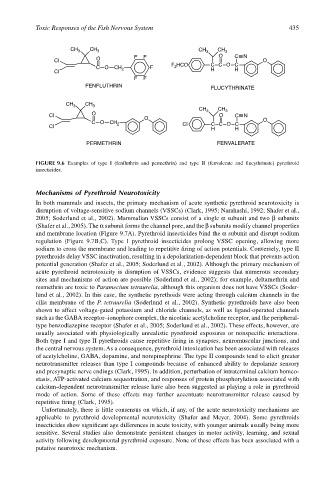Page 455 - The Toxicology of Fishes
P. 455
Toxic Responses of the Fish Nervous System 435
CH
CH 3 3 CH 3 CH 3
CI O F F O CN O
F HCO C C O C
C O CH 2 F 2
CI H H
F F
FENFLUTHRIN
FLUCYTHRINATE
CH 3 CH 3
CH
CH 3 3
CI O O O CN
C O CH O
CI 2 CI C C OC
H H
PERMETHRIN FENVALERATE
FIGURE 9.6 Examples of type I (fenfluthrin and permethrin) and type II (fenvalerate and flucythrinate) pyrethroid
insecticides.
Mechanisms of Pyrethroid Neurotoxicity
In both mammals and insects, the primary mechanism of acute synthetic pyrethroid neurotoxicity is
disruption of voltage-sensitive sodium channels (VSSCs) (Clark, 1995; Narahashi, 1992; Shafer et al.,
2005; Soderlund et al., 2002). Mammalian VSSCs consist of a single α subunit and two β subunits
(Shafer et al., 2005). The α subunit forms the channel pore, and the β subunits modify channel properties
and membrane location (Figure 9.7A). Pyrethroid insecticides bind the α subunit and disrupt sodium
regulation (Figure 9.7B,C). Type I pyrethroid insecticides prolong VSSC opening, allowing more
sodium to cross the membrane and leading to repetitive firing of action potentials. Conversely, type II
pyrethroids delay VSSC inactivation, resulting in a depolarization-dependent block that prevents action
potential generation (Shafer et al., 2005; Soderlund et al., 2002). Although the primary mechanism of
acute pyrethroid neurotoxicity is disruption of VSSCs, evidence suggests that numerous secondary
sites and mechanisms of action are possible (Soderlund et al., 2002); for example, deltamethrin and
resmethrin are toxic to Paramecium tetraurelia, although this organism does not have VSSCs (Soder-
lund et al., 2002). In this case, the synthetic pyrethoids were acting through calcium channels in the
cilia membrane of the P. tetraurelia (Soderlund et al., 2002). Synthetic pyrethroids have also been
shown to affect voltage-gated potassium and chloride channels, as well as ligand-operated channels
such as the GABA receptor–ionophore complex, the nicotinic acetylcholine receptor, and the peripheral-
type benzodiazepine receptor (Shafer et al., 2005; Soderlund et al., 2002). These effects, however, are
usually associated with physiologically unrealistic pyrethroid exposures or nonspecific interactions.
Both type I and type II pyrethroids cause repetitive firing in synapses, neuromuscular junctions, and
the central nervous system. As a consequence, pyrethroid intoxication has been associated with releases
of acetylcholine, GABA, dopamine, and norepinephrine. The type II compounds tend to elicit greater
neurotransmitter releases than type I compounds because of enhanced ability to depolarize sensory
and presynaptic nerve endings (Clark, 1995). In addition, perturbation of intraterminal calcium homeo-
stasis, ATP-activated calcium sequestration, and responses of protein phosphorylation associated with
calcium-dependent neurotransmitter release have also been suggested as playing a role in pyrethroid
mode of action. Some of these effects may further accentuate neurotransmitter release caused by
repetitive firing (Clark, 1995).
Unfortunately, there is little consensus on which, if any, of the acute neurotoxicity mechanisms are
applicable to pyrethroid developmental neurotoxicity (Shafer and Meyer, 2004). Some pyrethroids
insecticides show significant age differences in acute toxicity, with younger animals usually being more
sensitive. Several studies also demonstrate persistent changes in motor activity, learning, and sexual
activity following developmental pyrethroid exposure. None of these effects has been associated with a
putative neurotoxic mechanism.

